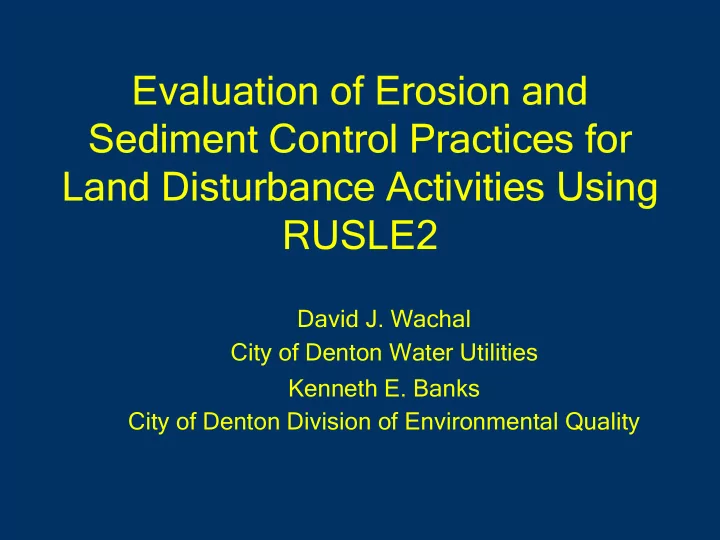

Evaluation of Erosion and Evaluation of Erosion and Sediment Control Practices for Sediment Control Practices for Land Disturbance Activities Using Land Disturbance Activities Using RUSLE2 RUSLE2 David J. Wachal City of Denton Water Utilities Kenneth E. Banks City of Denton Division of Environmental Quality
Erosion from Land Disturbance Erosion from Land Disturbance • Sediments are the single most widespread pollutant affecting the water quality in rivers and streams (USEPA, 2000) • Physical, chemical, and biological damage from erosion and sedimentation in North America may exceed $16 billion annually (Osterkamp et al., 1998) • In developing urban areas, construction activities are responsible for 50 to 90% of sediment entering surface waters (Burton and Pitt, 2002; Canning, 1998) • Sediment yields from construction activities range from a few tons to over 500 tons per acre per year (USEPA, 2002a)
Research Objective Research Objective • The objective of this research was to evaluate the relative effectiveness of BMP alternatives for natural gas well sites – Modeling approach using the Revised Universal Soil Loss Equation (RUSLE, Version 2) – Three slope profiles – Three soil erodibility factors • Short-term goal - understand how slope and soil might effect various BMP efficiencies • Long-term goal – use quantitative results to improve storm water component of existing ordinance
Study Study Area Area City of Denton
Site Characteristics Site Characteristics • Construction activities from natural gas well sites disturb a substantial amount of the ground surface (2-5 acres) • Completed sites may have moderate to steep cut and fill slopes that are unprotected from erosion • Pad sites are semi-permeable • Construction activities and field operations for oil and gas exploration and production are exempt from NPDES permitting
Site Grading Site Grading
Bird’s Eye View of Site Bird’s Eye View of Site Development Development
Drilling in Process Drilling in Process
Natural Gas Well Site Natural Gas Well Site
Methodology Methodology • Average annual sediment yields were modeled using RUSLE2 • For each slope and soil combination sediment yields were modeled with and without BMPs • BMP Efficiencies were calculated accordingly: ER = ( SY without BMP – SY withBMP ) / SY without BMP ER = (50 tons – 10 tons) / 50 tons = 80% efficiency
Modeled BMPs Modeled BMPs • Seeding Erosion Control • Mulching • Erosion Blanket • Silt Fence • Filter Strip Sediment Control • Sediment basin
About the RUSLE2 About the RUSLE2 • Public domain model – developed and maintained by USDA – Agricultural Research Service – Model Documentation (Foster, 2003) • Specifically designed as a conservation management tool for a variety of different land uses • Intended to be used uncalibrated • Estimates average annual sediment yields • Easily customizable to specific site characteristics and geographical regions
How RUSLE2 Works How RUSLE2 Works Sediment addition Incoming sediment by Interrill erosion load from upslope segment Sediment leaving segment greater if rill erosion occurs Sediment leaving segment less if deposition occurs Sediment addition by rill erosion OR Sediment removal by deposition
Modeled Site Slopes Modeled Site Slopes 4.5% Slope 5 2.9% Slope 4 1.8% Slope 3 2 1 0 0 20 40 60 80 100 3 Each slope was simplified to 9 slope segment for modeling 2 1 0 0 20 40 60 80 100
Area Area Soils Soils (NRCS, 2006)
Results Results Sediment Yield without BMPs (tons/acre/yr) Sediment Yield without BMPs (tons/acre/yr) K-factor K-factor K-factor 0.17 0.32 0.43 Sandy Clay Silty Clay Loam Loam Loam 1.8% 5.4 5.4 8.7 8.7 13.0 13.0 slope 2.9% 11.0 11.0 17.0 17.0 27.0 27.0 slope 4.5% 25.0 25.0 38.0 38.0 60.0 60.0 slope
Results Results BMP Efficiencies for 2.9% Slope BMP Efficiencies for 2.9% Slope 1.00 0.90 Seeding Mulching 0.80 Erosion Blanket Effic Ef ficiency ency Silt Fence (full) 0.70 Filter Strip Sediment Basin 0.60 0.50 Low Moderate High Soil Erodibility Soil Erodibility
Results Results BMP Efficiencies for 0.32 k-factor BMP Efficiencies for 0.32 k-factor 1.00 0.90 Seeding Mulching 0.80 Erosion Blanket Efficie Efficiency Silt Fence (full) 0.70 Filter Strip Sediment Basin 0.60 0.50 Low Moderate High Slope Slope
Results Results BMP Efficiencies for Combined Factors BMP Efficiencies for Combined Factors 1.00 0.90 Seeding Mulching 0.80 Erosion Blanket Efficiency Efficie Silt Fence (full) 0.70 Filter Strip Sediment Basin 0.60 0.50 Low Slp/Low Mod Slp/Mod High Slp/High Erod Erod Erod
Conclusion Conclusion • Without BMPs, modeled sediment yields ranged from 5 to 60 tons per acre per year • With BMPs, sediment yields were reduced by 50 to over 90 percent • Soils and slope can both influence BMP efficiency • Methodology can be used to assist in the selection of BMPs according to various site factors
References References Burton G.A., & Pitt, R.E. (2002). Stormwater effects handbook: A toolbox for watershed managers, scientists, and engineers . Boca Raton: Lewis Publishers. Canning, D.J. (1988). Construction erosion control : Shorelands Technical Advisory Paper No. 3. Olympia, WA.: Shorelands and Coastal Zone Management Program, Washington Department of Ecology. Foster, G.R., D.C. Yoder, G.A. Weesies, D.K. McCool, K.C. McGregor, and R.L. Bingner. (2003). RUSLE2 user’s guide . USDA-Agricultural Research Service, Washington, D.C. Osterkamp, W.R., Heilman, P., & Lane, L.J. (1998). “Economic considerations of a continental sediment-monitoring program.” International Journal of Sediment Research, 13(4), 12-24. Natural Resources Conservation Service (NRCS) (2006). NCSS Web Soil Survey. Retrieved October 1, 2006 from http://websoilsurvey.nrcs.usda.gov/app/ U.S. Environmental Protection Agency (USEPA) (2000). National Water Quality Inventory 1998 Report to Congress ’ USEPA 841-R-00-001; USEPA, Office of Water; Washington, D.C. U.S. Environmental Protection Agency (USEPA) (2002a). National management measures to control nonpoint source pollution from urban areas – draft . EPA 842-B-02-003. Washington, D.C.
Thank you Thank you David Wachal City of Denton david.wachal@cityofdenton.com (940) 349-7107
Recommend
More recommend